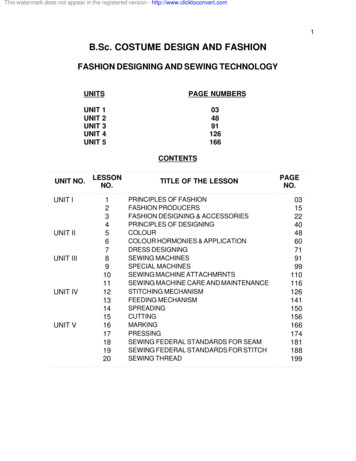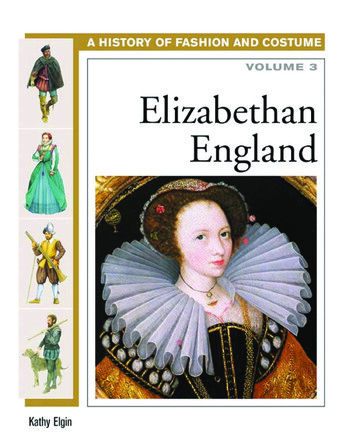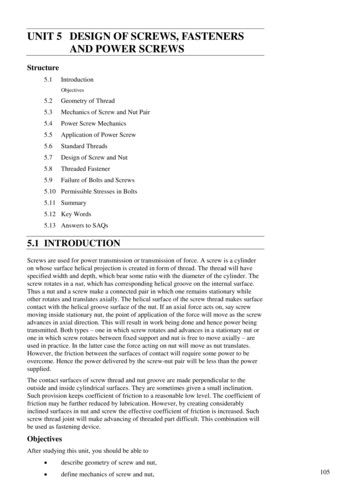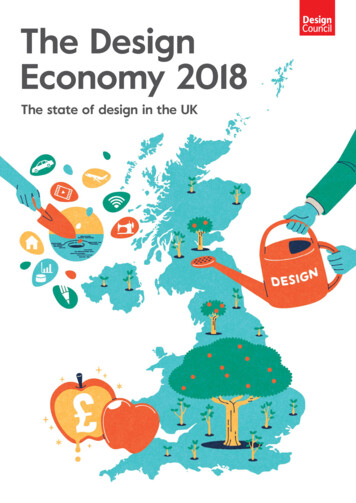
Transcription
This watermark does not appear in the registered version - http://www.clicktoconvert.com1B.Sc. COSTUME DESIGN AND FASHIONFASHION DESIGNING AND SEWING TECHNOLOGYUNITSPAGE NUMBERSUNIT 1UNIT 2UNIT 3UNIT 4UNIT 5034891126166CONTENTSUNIT NO.UNIT IUNIT IIUNIT IIIUNIT IVUNIT VLESSONNO.TITLE OF THE LESSON1234567891011121314151617181920PRINCIPLES OF FASHIONFASHION PRODUCERSFASHION DESIGNING & ACCESSORIESPRINCIPLES OF DESIGNINGCOLOURCOLOUR HORMONIES & APPLICATIONDRESS DESIGNINGSEWING MACHINESSPECIAL MACHINESSEWING MACHINE ATTACHMRNTSSEWING MACHINE CARE AND MAINTENANCESTITCHING MECHANISMFEEDING MECHANISMSPREADINGCUTTINGMARKINGPRESSINGSEWING FEDERAL STANDARDS FOR SEAMSEWING FEDERAL STANDARDS FOR STITCHSEWING 66174181188199
This watermark does not appear in the registered version - http://www.clicktoconvert.com2UNIT – ILESSON – 1: PRINCIPLES OF FASHIONCONTENTS1.01.1AIM AND OBJECTIVESINTRODUCTION1.2FASHION1.2.1 Fashion design terms1.3.1.2.2Areas of fashion1.2.3Fashion flow chart1.2.4 Fashion in ClothsCLASSIFICATION OF FASHION1.3.1Style1.3.2Basic or classics1.3.31.3.4FadFashion Forecasting1.3.5Trends1.4CHIC1.51.6COSTUME MADECOLLECTION1.7MANNEQUINS1.8FASHION SHOWS:1.8.11.8.2Formal fashion showsDesigner trunk shows1.8.3Department fashion shows1.8.4Informal fashion shows1.9FASHION CYCLES1.9.1 Length of cycles1.10LET US SUM UP1.11LESSON END ACTIVITIES1.121.13POINTS FOR DISCUSSIONREFERANCES
This watermark does not appear in the registered version - http://www.clicktoconvert.com31.0 AIM AND OBJECTIVESThe aim of this lesson is to give better knowledge to students about the field of fashion &related terms and fashion cycles.Ø Here we discussed all the area of fashion field which includes terms of fashion, fashionsources and fashion cycle.Ø In fashion cycle point of view, it deals the principles of fashion, peak, decline, length offashion cycleØ Fashion show and its type, fashion forecasting and classification of fashion will give ideaabout fashion.1.1 INTRODUCTIONFashion in the narrow sense of the world means the changing form of clothing. Theseoriginate from peoples need to be adorned and admired nut also allow the opportunity to enhancepersonal style or indicate a position in society. Fashion is not the only consideration indeveloping a garment for a market. The overall appearance (style) as well as the utility value(fitness for purpose, aftercare) also have.Here we studied about introductory concept of fashion, fashion terms and fashionforecasting. In this lesion we will go through another important function of fashion cycle,classification of fashion and fashion shows.1.2 FASHIONFashion is a term that usually applies to a prevailing mode of expression, but quite oftenapplies to a personal mode of expression that may or may not apply to all. Inherent in the term isthe idea that the mode will change more quickly than the culture as a whole. The terms"fashionable" and "unfashionable" are employed to describe whether someone or something fitsin with the current popular mode of expression. The term "fashion" is frequently used in apositive sense, as a synonym for glamour and style. In this sense, fashions are a sort ofcommunal art, through which a culture examines its notions of beauty and goodness.1.2.1 FASHION DESIGN TERMS···A fashion designer conceives garment combinations of line, proportion, color, andtexture. He or she may or may not know how to sew or make patterns. Formal training isalways essential, yet most fashion designers are formally trained (apprenticed) andschooled.A pattern maker drafts the shapes and sizes of a garment's pieces with paper andmeasuring tools, and, some times, an AutoCAD computer software program, or bydraping muslin on a dress form, the original way. The resulting pattern pieces mustcompose the intended design of the garment and they must fit the intended wearer.Formal training is essential for working as a pattern marker.A tailor makes custom designed garments made to the client's measure; suits (coat andtrousers, jacket and skirt, et cetera).
This watermark does not appear in the registered version - ···A textile designer designs fabric weaves and prints for clothes and furnishings. Mosttextile designers are formally trained as apprentices and in school.A stylist is the person who co-ordinates the clothes, jewelry, and accessories used infashion photography and catwalk presentations of clothes collections. A stylist also is adesigner whose designs are based upon extant things, trends, and the collections of otherdesigners.A buyer orders stocks of clothes for shops, chain stores, and other types of stores. Mostfashion buyers are trained in business studies.A seamstress sews seams wither manually or with a sewing machine, either in a garmentshop or as a sewing machine operator in a factory. She (or he) may not have the skills tomake (design and cut) the garments, or to fit them on a model. A seamstress is notsynonymous with dressmaker.A teacher of fashion design teaches the art and craft of fashion in art schools and infashion design school.A custom clothier makes custom- made garments to order, for a given customer.A dressmaker specializes in custom- made women's clothes: day, cocktail, and eveningdresses, business clothes and suits, trousseaus, sports clothes, and lingerie.An illustrator draws and paints clothes for commercial use.A model wears and displays clothes at fashion shows and in photographs.A fashion journalist writes fashion articles describing the garments presented, formagazines or newspapers.An alterations specialist (alterationist) adjusts the fit of completed garments, usuallyready-to-wear, and sometimes re-styles them. NOTE: despite tailors altering garments tofit the client, not all alterationists are tailors.A wardrobe consultant or fashion advisor recommends styles and colors that are flatteringto the client.A photographer photographs the clothes on fashion models for use in magazines,newspapers, or adverts.1.2.2 AREAS OF FASHIONFashions are social phenomena common to many fields of human activity and thinking.The rises and falls of fashions have been especially documented and examined in the followingfields:··········Architecture, interior design, and landscape designArts and craftsBody type, clothing o r costume, cosmetics, grooming, hair style, a n d personaladornmentDance and musicForms of address, slang, and other forms of speechEconomics and spending choices, as studied in behavioral financeEntertainment, games, hobbies, sports, and other pastimesEtiquetteManagement, management styles and ways of organizingPolitics and media, especially the topics of conversation encouraged by the media
This watermark does not appear in the registered version - http://www.clicktoconvert.com5·Philosophy and spirituality (One might argue that religion is prone to fashions, althoughofficial religions tend to change so slowly that the term cultural shift is perhaps moreappropriate than "fashion")· Social networks and the diffusion of representations and practices· Sociology and the meaning of clothing for identity-building· Technology, such as the choice of programming techniquesOf these fields, costume especially has become so linked in the public eye with the term"fashion". The more general term "costume" has been relegated by many to only mean fancydress or masquerade wear, while the term "fashion" means clothing generally, and the study ofit. This linguistic switch is due to the so-called fashion plates which were produced during theIndustrial Revolution, showing novel ways to use new textiles. For a broad cross-cultural look atclothing and its place in society, refer to the entries for clothing and costume.1.2.3 FASHION FLOW CHART
This watermark does not appear in the registered version - http://www.clicktoconvert.com61.2.4 FASHION IN CLOTHSFashion in clothes has allowed wearers to express emotion or solidarity with other peoplefor millennia. Modern Westerners have a wide choice available in the selection of their clothes.What a person chooses to wear can reflect that person's personality or likes. When people whohave cultural status start to wear new or different clothes a fashion trend may start. People wholike or respect them may start to wear clothes of a similar style.Fashions may vary significantly within a society according to age, social class,generation, occupation and geography as well as over time. If, for example, an older persondresses according to the fashion of young people, he or she may look ridiculous in the eyes ofboth young and older people. The terms " fashionista" or "fashion victim" refer to someone whoslavishly follows the current fashions (implementations of fashion).1.3. CLASSIFICATION OF FASHIONThe duration of fashion’s importance is a critical fashion designers or manufacturesconcern. A fashion can be brief or of long duration. Once having identified this characteristic, adesigner is in a position to assess a fashions importance to the retail inventory.Fashion is classified into many types, such as:ØØØØØStyleBasic or classicFadFashion ForecastingTrends1.3.1 STYLEStyle is always constant. It does not change whereas fashion changes. It is not constant. It isthe modification of fashion. Style is the basic outline of any garment. When we ass a differentneckline and different sleeves with some trimming here and there over a basic garment then thebasic garment is modified into a different look or a different outfit, this modification ferment willbecome fashion, when it is accepted by people.The term style is a popular word in fashion and refers to a sub-division within fashion. Bydefinition, it is that which has certain characteristics that distinguish it from other designs. Forexample, the fashion could be pleated skirt, yet the style is box pleat. It is a common fallacy tobelieve that the famous designers create fashions. They create styles which they hope will beaccepted. When and if there is consumer support the style then becomes fashion. It is repetitiousbut important to stress that fashion is synonymous with acceptance.1.3.2 BASIC OR CLASSICSWhen a fashion is constant or long lasting, such as, salwar kameez and saree, it is calledBasic or Classic. It is similar to a standard music. The salwar kameez and saree are part offashion scene. A customer has one or more in her wardrobe, to be worn to suit different
This watermark does not appear in the registered version - http://www.clicktoconvert.com7occasions. In certain times, the basic becomes the most important promotable fashion, but, in orout, they remain as a part of the fashion secne. Threre are many outfits that fall into thisclassification, such as, chudidhar, kurta, dupattas, shirt and trousers, plain or pleated skirts anddenims, etc. there are general fashions that lasts for years, such as, the saree, the single breastedmen’s suitBasics or Classics are the outfits which stays in the fashion scene for a long period of timethat is from past to present and even in future it standsWhen we watch old movies as well as the new movies which are released just, we can seethe saris and salwar kameez worn in it may be with a slight change or modification accordingly.1.3.3 FADA Fad is something which can either make a designer’s life more interesting or tenser. Veryoften something appears on the fashion scene tat captures the imagination, only to fizzle out inshort duration.Overall, Fad can be defined as short lived fashion, lasting for a very little time or period,acceptable by only a certain group of people. For example, hippies – their clothing, accessories,hairstyles, etc.As Fad is short lived fashion, it stays for a very short period, because they are very costlyand every one cannot afford to buy it. For example, dhoti salwar, tube shirts and so on.A fashion expert is a selection for consumers – selecting what is more likely to be acceptedgoing overboard for short lived fashion – Fad can be costly1.3.4 FASHION FORECASTINGThis is the important part of fashion scenario because when any new garment is designed bythe designer and worn, it will not create fashion by itself. It needs the media to spread fashionand this media which spread fashion and gets the fame and name to the designers is FashionForecasting.Fashion Forecasting is done through many communicating media, such as, cinema, fashionshows, press, magazines, newspapers and window display.It includes· Market research· Consumer researcho Surveyso Consumer focus groupso In-store informal interviews· Shopping· Sales Records· Evaluating the collections· Fashion Trends· Trend for Target Markets
This watermark does not appear in the registered version - http://www.clicktoconvert.com8Fashion Forecasting is done where crowd is formed in such occasion, so that it can createfashion.1.3.5 TRENDSFashion trends are the styling ideas that major collections have in common. They indicatethe direction in which fashion is moving. Fashion forecasters look for the styles they think areprophetic, ideas that capture the mood of the times and signal a new fashion trend.Several designers may use a similar fashion idea because they have been inspired bycommon sources. The trend may appear in a fabrication, a silhouette, or another design elementthat appears in several collections. Very often, a new trend appears in small doses until it spreadsto other collections. As the press notices similarities between collections and highlights them, themedia exposure also helps establish the trends.Evaluating the collections becomes one way a designer, working for a mainstreammanufacturer, can research fashion direction. As designers are not invited to the shows, theymust evaluate by shopping in major fashion capitals or using design services, magazines, andnewspapers.For retail buyers, it is becoming a huge challenge to figure out which trends will becomefashion basics, like capris, and which are only fads, such as pony prints. Buyers have to becomevery flexible in their buying patterns and cautious about inventory management. If the marketbecomes flooded with a new trend, consumers may react negatively to the overexposure.Empowered by the Internet and television, global trends are moving at an accelerating pace.The life-span of a trend is now about five months instead of a year. For the junior market, thespan is only three months.1.4 CHICChic is a French word, established in English since at least the 1870s, that has come tomean smart or stylish. Over the years "chic" has been applied to, among other things, socialevents, situations, individuals, and modes or styles of dress. Recurring generic terms includeddesigner chic (associated with the styles of particular coutouriers - the 1980s became known asthe "designer decade") and retro-chic (adopting elements of fashion from the past: e.g. "Victorianchic", "sixties chic", "Georgian chic", "1920s Riviera chic"1.5 COSTUME MADE:The elaborate detail and intricate and dressmaking at that time required an enormousamount of painstaking hand labor. All clothes were not only hand make but also custom- made.Each garment was made to fit the customer’s exact measurements. Dresses and suits wereindividually sewn by dressmakers or tailors to their employers specifications. The identities ofpersonal dressmakers were secrets guarded by the wealthy. No one wanted to share the talents ofclever dressmakers for fear of losing them.
This watermark does not appear in the registered version - http://www.clicktoconvert.com91.6 COLLECTIONEach season, the design and merchandising departments of each division are responsible forcreating a new line, the seasonal collection that the manufacturer will sell to retail store buyers.The terms are synonymous: Collection is used primarily in Europe and for high-period apparel inthe United States. Line is used more often in the United States for moderately and popularlypriced fashion.1.7 MANNEQUINSMannequins change with fashion trends and are made in the image of the current ideal ofbeauty. For elegant fashion, perfectly coiffed, traditional life- like Mannequins are preferred.However, they are very expensive to buy and to maintain. To save money, many stores havereplaced them with less expensive papier-mâché torsos or unpainted “Mannequins alternatives.”1.8 FASHION SHOWS:Fashion shows are special events that communicate a fashion story. The selection andorganization of the fashions and model bookings may be done by the fashion office, whereasinvitations and other arrangements may be handled by the special events department. There arefour possible ways to organize these presentations: formal shows, department shows, designertrunk shows, or informal modeling.1.8.1 FORMAL FASHION SHOWSFormal fashion shows take a great deal of advance planning involving booking models andfittings and arranging for a runway, scenery, lighting, microphones, music, seating, andassistants. Clothes are generally grouped according to styling, color, or other visual criteria.Models and music are selected to complement the clothes and set a mood.1.8.2 DESIGNER TRUNK SHOWSDesigner trunk shows are done in cooperation with a single vendor and are a popular way tosell expensive collections. Invitations are sent to the best customers according to records kept bysales associates. The designer or a representative travels from store to store with the collection,which is usually shown on models in the designer collections department. Customers get to seethe entire collection unedited by a buyer and may order from the samples in their size. Althoughsome designers and retailers do 50 percent of their total business through trunk shows, othersfind them time-consuming, exhausting work, and have given them up.1.8.3 DEPARTMENT FASHION SHOWSDepartment fashion shows, on a much smaller scale, are produced in store to generateimmediate sales. Usually, a platform is set up directly in the department that carries the clothes.
This watermark does not appear in the registered version - http://www.clicktoconvert.com101.8.4 INFORMAL FASHION SHOWSInformal fashion shows are the easiest to produce. A few models walk through the storeshowing the fashions that they are wearing to customers who are shopping or having lunch in thestore’s restaurant. The models can take their time, and customers enjoy asking them questions.This is often done in conjunction with a trunk show or special promotion.1.9 FASHION CYCLESConsumers are exposed each season to a multitude of new styles created by designers.Some are rejected immediately by the press or by the buyer on the retail level, but others areaccepted for a time, as demonstrated by consumers purchasing and wearing them.The way in which fashion changes is usually described as a fashion cycle. It is difficult tocategorize or theorize about fashion without oversimplifying. Even so, the fashion cycle isusually depicted as a bell shaped curve encompassing five stages: introduction, rise in popularity,peak of popularity, decline in popularity, and rejection. The cycle can reflect the acceptance of asingle style from one designer or a general style such as the miniskirt.1. Introduction of a style:Designers interpret their research and creative ideas into appeal or accessories and thenoffer the new styles to the public. Designers create new designs by changing elements such asline, shape, color , fabric, and details and their relationship to one another. New creationsreferred to as the “latest fashions” may not yet be accepted by anyone. At this first stage of thecycle, fashion implies only style and newness.Most new styles are introduced at a high price level. Designers who are globally respectedfor their talent may be given financial backing and be allowed to design with very fewlimitations on creativity, quality of raw materials, or amount of fine workmanship. Naturally,production costs are high, and only a few people can aff
B.Sc. COSTUME DESIGN AND FASHION FASHION DESIGNING AND SEWING TECHNOLOGY . and, some times, an AutoCAD computer software program, or by draping muslin on a dress form, the original way. The resulting pattern pieces must . designer is in a position to assess a fashions importance to the retail inventory. Fashion is classified into many types .File Size: 2MBPage Count: 197











